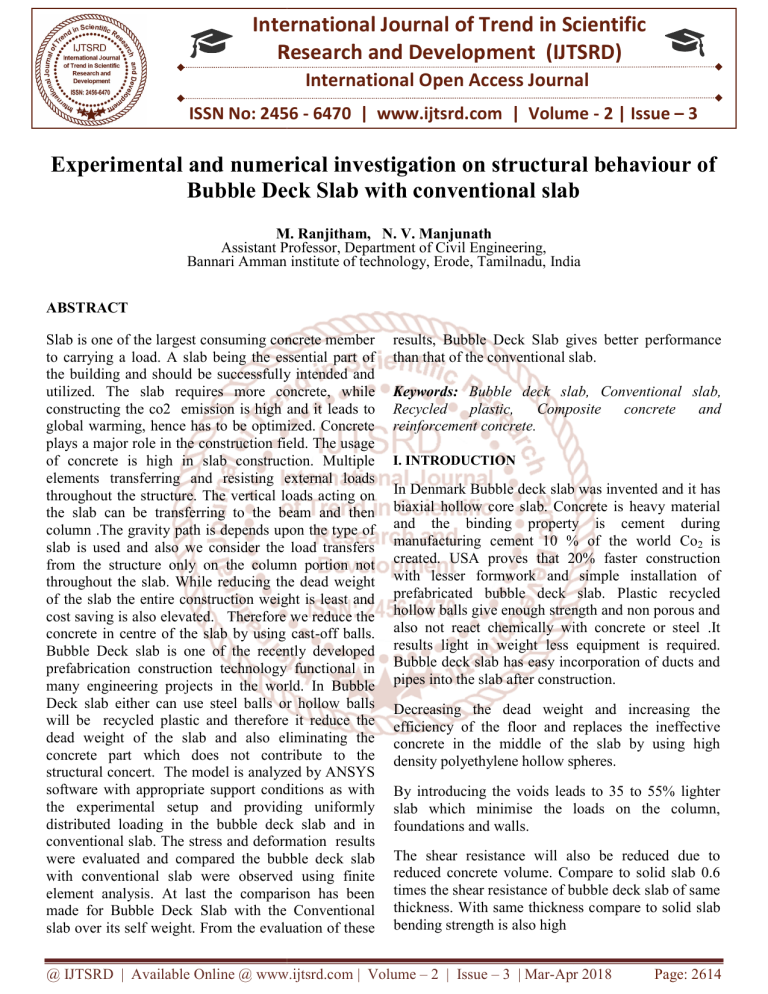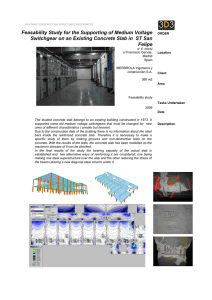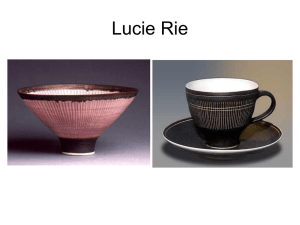
International Journal of Trend in Scientific
Research and Development (IJTSRD)
International Open Access Journal
ISSN No: 2456 - 6470 | www.ijtsrd.com | Volume - 2 | Issue – 3
Experimental and numerical investigation on structural behaviour of
Bubble Deck Slab with conventional slab
M. Ranjitham, N. V. Manjunath
Assistant Professor
Professor, Department of Civil Engineering,
Bannari Amman institute of technology, Erode, Tamilnadu, India
ABSTRACT
Slab is one of the largest consuming concrete member
to carrying a load. A slab being the essential part of
the building and should be successfully intended and
utilized. The slab requires more concrete, while
constructing the co2 emission is high and it leads to
global warming, hence has to be optimized. Concrete
plays a major role in the construction field. The usage
of concrete is high in slab construction. Multiple
elements transferring and resisting external loads
throughout the structure. The verticall loads acting on
the slab can be transferring to the beam and then
column .The gravity path is depends upon the type of
slab is used and also we consider the load transfers
from the structure only on the column portion not
throughout the slab. While reducing
ing the dead weight
of the slab the entire construction weight is least and
cost saving is also elevated. Therefore we reduce the
concrete in centre of the slab by using cast
cast-off balls.
Bubble Deck slab is one of the recently developed
prefabrication construction
struction technology functional in
many engineering projects in the world. In Bubble
Deck slab either can use steel balls or hollow balls
will be recycled plastic and therefore it reduce the
dead weight of the slab and also eliminating the
concrete part which does not contribute to the
structural concert. The model is analyzed by ANSYS
software with appropriate support conditions as with
the experimental setup and providing uniformly
distributed loading in the bubble deck slab and in
conventional slab. The
he stress and deformation results
were evaluated and compared the bubble deck slab
with conventional slab were observed using finite
element analysis. At last the comparison has been
made for Bubble Deck Slab with the Conventional
slab over its self weight.
t. From the evaluation of these
results, Bubble Deck Slab gives better performance
than that of the conventional slab.
Keywords: Bubble deck slab, Conventional slab,
Recycled
plastic,
Composite
concrete
and
reinforcement concrete.
I. INTRODUCTION
In Denmark Bubble deck slab was invented and it has
biaxial hollow core slab. Concrete is heavy material
and the binding property is cement during
manufacturing cement 10 % of the world Co2 is
created. USA proves that 20% faster construction
with lesser formwork and simple installation of
prefabricated bubble deck slab. Plastic recycled
hollow balls give enough strength and non porous and
also not react chemically with concrete or steel .It
results light in weight less equipment is required.
Bubble
ubble deck slab has easy incorporation of ducts and
pipes into the slab after
fter construction.
Decreasing the dead weight and increasing the
efficiency of the floor and replaces the ineffective
concrete in the middle of the slab by using high
density polyethylene hollow spheres.
By introducing the voids leads to 35 to 55% lighter
slab which minimise the loads on the column,
foundations and walls.
The shear resistance will also be reduced due to
reduced concrete volume. Compare to solid slab 0.6
times the shear resistance
sistance of bubble deck slab of same
thickness. With same thickness compare
c
to solid slab
bending strength is also high
@ IJTSRD | Available Online @ www.ijtsrd.com | Volume – 2 | Issue – 3 | Mar-Apr
Apr 2018
Page: 2614
International Journal of Trend in Scientific Research and Development (IJTSRD) ISSN: 2456-6470
Bending stresses are found to be 7% lower for Bubble
deck. Low deflection value for strengthened bubble
deck slab compare to conventional solid slab. 100mm
diameter size plastic ball is used. The recycled
polyethylene hollow spheres are shown in Fig 1.
3. To investigate the mechanical characteristics of
conventional slab & bubble deck slab.
4. To compare the results of analytical and
experimental
II. NUMERICAL INVESTIGATION WITH
ANSYS SOFTWARE
Fig 1 Recycled polyethylene hollow spheres
B. STEEL REINFORCEMENT
High grade steel of Fe 500 is generally used. The
same grade of steel is used in both in top and bottom
steel reinforcement. 10mm diameter steel bar is used
For main reinforcement 10mm diameter steel bar is
used and for distributor reinforcement 8mm diameter
steel bar is used
In this project, the structural behaviour and strength of
Bubble deck slab and Conventional slab are
investigated using finite element software ANSYS.
The finite element method is extensively used to study
the behaviour of the structure such as shear strength,
Equivalent stress, ultimate load, crack pattern,
deflection at mid portion of slab for both Bubble deck
slab and for Conventional slab.. The interconnected
element may have different size and shape and
connected at finite number of points called nodes. The
test parameters included diameters of ball, slab
thickness, width of the slab are feed into ANSYS.
A. NUMERICAL MODELLING
Fig 2 Reinforcements
C. MATERIALS USED FOR CONSTRUCTION
Ordinary Portland cement with well graded 12mm
diameter aggregates is used. Minimum grade of
concrete M30 and M40 is used. The depth of the slab
is about 200mm. The test were carried out according
to the IS 456-2000 standard. The conventional
concrete is shown in fig 3.
Fig 3 Concrete
Objectives of this project
The Bubble deck slab and conventional slab are
discretized using tetra hedral element type and it as 4
nodes and each node as 6 degree of freedom for
concrete, steel reinforcement and for balls; it is
suitable for both bubble deck slab and for
conventional slab. Simply support, support conditions
were provided for bubble deck slab and for
conventional slab. Here, one end of support acts as
hinge and other end of support which act as roller
support. UDL load is applied for the area of about
500mm x500mm over the top portion of the slab. An
axially compressive load was applied uniformly on
the top surface of slab with displacement control.
The size of the slab is 750mm x750mm x 200mm.
The reinforcement details and model is drawn using
AUTO CAD software for both bubble deck slab and
for conventional slab and then it exported to ANSYS
Workbench14.5 as 3D solid objects with identical
geometry.
B. NUMERICAL INVESTIGATION
BUBBLE DECK SLAB
FOR
1. The main purpose of this project is to replacing
concrete with recycled polyethylene hollow spheres
in rcc slab
2. The structure is generally designed, using the
conventional design methods for solid floor slabs &
bubble deck slab.
Figure 4 Modeling of Bubble Deck Slab
@ IJTSRD | Available Online @ www.ijtsrd.com | Volume – 2 | Issue – 3 | Mar-Apr 2018
Page: 2615
International Journal of Trend in Scientific Research and Development (IJTSRD) ISSN: 2456-6470
Figure 5 shows the behaviour of deflection of the
bubble deck slab
Figure 8 Equivalent stresses for Conventional slab
III.EXPERIMENTAL INVESTIGATION
A. Experimental procedure
Two type of specimens were casted, first one was a
conventional one-way R.C slab and second one was
one-way Bubble deck slab. The size of both slabs is
750mm x 750mm x 200mm. The slab was simply
supported at two sides which had a hinge support at
one end and roller support at other end of slab.
Figure 6 shows behaviour of deflection of
Conventional slab
Specimens were tested in Test Frame by applying
Uniformly distributed load over the top portion of
slab. The capacity of hydraulic jack IS maximum
loading 500KN.
Deflections were measured at mid span of the both
Conventional slab and for Bubble deck slab and strain
was measured using strain gauge. The load was
increased gradually at increments of 10KN to record
the deflection up to failure.
Figur e7 shows of Equivalent stress for bubble deck
slab
Figure 10 Testing in a loading frame
@ IJTSRD | Available Online @ www.ijtsrd.com | Volume – 2 | Issue – 3 | Mar-Apr 2018
Page: 2616
International Journal of Trend in Scientific Research and Development (IJTSRD) ISSN: 2456-6470
VI. RESULT
400
300
200
100
0
REFERENCES
load
deflection
Weight
In that experiment found that volume of concrete the
bubble deck (continuous) is reduced so that weight
of slab ultimately decrease.
Type of Load
Deflecti
Weight
slab
(Kn)
on(mm)
(Kg)
250
13
320
Conventi
onal slab
320
15
245
Bubble
deck slab
Table no 1 comparison of results in experimental
analyis
CONCLUSION
A. Weight reduction is 25% compared to solid slab.
B. The bubble deck technology is environmentally
green and sustainable; avoiding the cement production
allows reducing global CO2 emissions.
C. In comparative of conventional slab the volume of
concrete in bubble deck (continuous) are less
required, that is 25% approximately.
D. Simultaneously, bubble deck slab has improve the
elasticity property of slab,
E. Cost and time saving by using bubbles in slab like
weight of slab, concrete volume indirectly load on the
beam and walls also decrease/ less so that building
foundations is designed for smaller dead loads.
F. It is concluded that Load, deflection and weight
parameters gives better result for bubble deck slab as
compared to conventional slab.
G. Both in numerical and experimental results bubble
deck slab shows a high load bearing capacity
1) Arati Shetkarand & Nagesh Hanche, “An
Experimental Study On bubble deck slab system
with elliptical balls”, NCRIET2015 &Indian
J.Sci.Res. 12(1):021-027, 2015.
2) Harishma K.R and Reshmi K N, “A study on
Bubble Deck slab”, International Journal of
Advanced Research Trends in Engineering and
Technology (IJARTET) Vol. II, Special Issue X,
March 2015.
3) Subramanian K and Bhuvaneshwari P, “Finite
Element Analysis of Voided Slab with High
Density
Polypropylene
Void
Formers”,
International Journal of Chem Tech Research,
CODEN (USA): IJCRGG ISSN: 0974-4290,
Vol.8, No.2, pp. 746-753, 2015.
4) Saifee Bhagat, Dr. K. B. Parikh, “Comparative
Study of Voided Flat Plate Slab and Solid Flat
Plate Slab”, ISSN 2278 – 0211, Vol. 3 Issue 3,
March, 2014.
5) A. Churakov Biaxial hollow slab with innovative
types of voids, Saint-Petersburg Polytechnical
University,
29
Polytechnicheskayast.
St.
Petersburg, 195251, Russia, ISSN 2304-6295.6
(21) 2014. 70-88. 8.
6) Amer M. Ibrahim, Nazar K. Ali, Wissam D.
Salman “Flexural capacities of reinforced concrete
two-way bubble deck slabs of plastic spherical
voids” Diyala Journal of Engineering Sciences,
ISSN 1999-8716, Vol. 06, No. 02, June 2013. 9.
L. R. terec,
7) M. A. Terec The bubbledeck floor system: a brief
presentation, CS I, INCD URBAN-INCERC
Branch of Cluj-Napoca, CONSTRUCŢII – No. 2 /
2013. 10.
8) Wesley N. Mascarenhas Viscoelastic Analysis of
Biaxial Hollow Deck Balls, International Journal
of Computer Aided Engineering, ISSN: 10712317, Vol.23, Issue.1,© recent science
publications archives, January 2013.
9) Gudmand-Hoyer T., “Note on the moment
capacity in a Bubble Deck Joint”, Rapport BYGDenmark Tekniske Universitet R-074, ISSN 16012917,ISBN 87-7877-136-6,2003.
10) Nielsen M., “Limit Analysis and Concrete
Plasticicity”, Second Editi on, CRC Press, 1998
@ IJTSRD | Available Online @ www.ijtsrd.com | Volume – 2 | Issue – 3 | Mar-Apr 2018
Page: 2617




